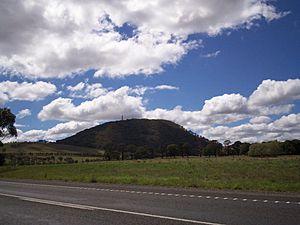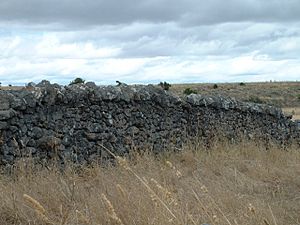Western Victorian Volcanic Plains facts for kids
The Western Victorian Volcanic Plains are a huge area in Victoria, Australia, covered by ancient lava flows. They are also called the Newer Volcanic Province. These plains are the third largest volcanic plains on Earth! Only the Deccan Plateau in India and the Snake River Plateau in the USA are bigger.
The Western Victorian Volcanic Plains cover a massive 2.3 million hectares. That's more than 10% of the entire state of Victoria. These plains were formed by volcanoes erupting over the last 6 million years. The most recent eruption happened at Mount Napier about 7,200 years ago. Only a few rivers flow across these plains, including the Barwon, Hopkins, Leigh, Maribyrnong, Wannon, and Werribee Rivers, plus the Mount Emu Creek. Sadly, more than 90% of these plains have been cleared for farming.
Scientists have found over 400 volcano sites on the plains. Near Ballarat, the volcanoes are quite close together. The plains grew over time from many small lava flows. The average depth of this hardened lava is about 60 metres. Many of the volcanic features stand out clearly on the otherwise flat land.
Contents
History of the Volcanic Plains
The Aboriginal people who lived here must have seen some of these eruptions. They told stories about rocks and fire coming from certain mountains. Stone tools from ancient times have been found buried in volcanic ash near Warrnambool.
The first European to describe the Western Volcanic Plains was Major Thomas Mitchell. He climbed Mount Napier in 1836. He wrote that it looked like the volcano had been active not long before. Early settlers liked the plains because they could easily grow crops in the rich, fertile soil. They also used the volcanic stones to build strong dry stone walls around their farms.
Are the Volcanoes Still Active?
The Western Victorian Volcanic Plains have been quiet for thousands of years. There have been no earthquakes, no hot springs, or other signs of activity. It's not fully known why the volcanoes stopped erupting. Some scientists believe the volcanoes on the plains are not truly extinct (meaning they will never erupt again). Instead, they think they are dormant, which means they are just sleeping and could possibly erupt again one day.
Cool Volcanic Features to Explore
The Western Victorian Volcanic Plains are home to many interesting volcanic features. Here are some of them:
- Bald Hill, north of Craigieburn
- Blue Mount
- Brocks Monument
- Camel's Hump
- Granville Hill
- Green Hill, near Wallan
- Green Hill near Buninyong
- Green Hill near Pootilla
- Green Hill near Snake Valley
- Hanging Rock
- Happy Valley
- Hardie Hill
- Hayes Hill near Donnybrook
- The Jim Jim
- Lake Bullenmerri
- Lake Keilambete
- Lake Purrumbete
- Lake Terang
- Larundel Hill
- Magnet Hill (45 metres tall)
- Melbourne Hill (75 metres tall)
- Mount Aitken
- Mount Blackwood
- Mount Bullengarook
- Mount Buninyong
- Mount Cotterell
- Mount Eccles
- Mount Elephant
- Mount Franklin
- Mount Fraser (120 metres tall)
- Mount Gisborne (100 metres tall)
- Mount Hamilton
- Mount Holden (75 metres tall)
- Mount Kooroocheang
- Mount Koroit (60 metres tall)
- Mount Lawaluk
- Mount Leura
- Mount Mercer
- Mount Moorookyle
- Mount Napier
- Mount Noorat
- Mount Pisgah
- Mount Porndon (278 metres tall)
- Mount Rouse
- Mount Rowan (Victoria)
- Mount Shadwell
- Mount Warrenheip
- Mount Widderin
- Organ Pipes
- Pretty Sally Hill
- Red Rock near Alvie
- Red Rock near Gisborne
- Tower Hill
- Wallinduc Hill
Related pages




